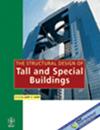Experimental study and numerical analysis of the interfacial bonding performance of T‐shaped concrete‐filled steel tubes
IF 1.3
3区 工程技术
Q3 CONSTRUCTION & BUILDING TECHNOLOGY
引用次数: 0
Abstract
The effects of core concrete strength (C30, C40, and C50), steel tube length (600, 1000, and 1400 mm), and steel tube wall thickness (3, 4, and 5 mm) on the bonding performance of T‐shaped concrete‐filled steel tubes (CFSTs) were systematically investigated using push‐out test. Via the test, the patterns of the failure modes, load‐slip curves, stress‐slip curves, and distribution law of longitudinal strain were observed for the specimens, and the bond‐slip constitutive model for T‐shaped CFSTs was established. The test results indicate that the bond stress of T‐shaped CFSTs increases with the increase in concrete strength and tube wall thickness, while the steel tube length has less influence on the bond stress. In addition, non‐linear spring elements were used to simulate the interfacial bonding behavior based on the bond‐slip equation, which is in good agreement with the experimental curve results.T形钢管混凝土界面粘结性能的试验研究与数值分析
核心混凝土强度(C30、C40和C50)、钢管长度(600、1000和1400)的影响 mm)和钢管壁厚(3、4和5 mm)对T型钢管混凝土(CFST)粘结性能的影响。通过试验,观察了试件的破坏模式、荷载-滑移曲线、应力-滑移曲线和纵向应变分布规律,建立了T型钢管混凝土的粘结-滑移本构模型。试验结果表明,T型钢管混凝土的粘结应力随着混凝土强度和管壁厚度的增加而增加,而钢管长度对粘结应力的影响较小。此外,基于粘结滑移方程,使用非线性弹簧单元模拟了界面粘结行为,与实验曲线结果吻合良好。
本文章由计算机程序翻译,如有差异,请以英文原文为准。
求助全文
约1分钟内获得全文
求助全文
来源期刊
CiteScore
5.30
自引率
4.20%
发文量
83
审稿时长
6-12 weeks
期刊介绍:
The Structural Design of Tall and Special Buildings provides structural engineers and contractors with a detailed written presentation of innovative structural engineering and construction practices for tall and special buildings. It also presents applied research on new materials or analysis methods that can directly benefit structural engineers involved in the design of tall and special buildings. The editor''s policy is to maintain a reasonable balance between papers from design engineers and from research workers so that the Journal will be useful to both groups. The problems in this field and their solutions are international in character and require a knowledge of several traditional disciplines and the Journal will reflect this.
The main subject of the Journal is the structural design and construction of tall and special buildings. The basic definition of a tall building, in the context of the Journal audience, is a structure that is equal to or greater than 50 meters (165 feet) in height, or 14 stories or greater. A special building is one with unique architectural or structural characteristics.
However, manuscripts dealing with chimneys, water towers, silos, cooling towers, and pools will generally not be considered for review. The journal will present papers on new innovative structural systems, materials and methods of analysis.

 求助内容:
求助内容: 应助结果提醒方式:
应助结果提醒方式:


